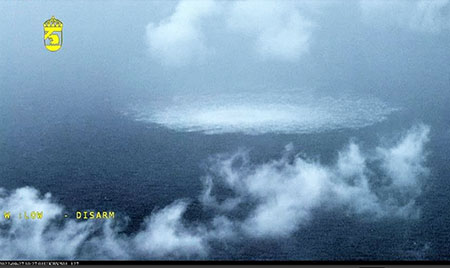by WorldTribune Staff, September 29, 2022
German security officials believe “highly effective explosive devices” were used to in sabotage attacks on Russia’s Nord Stream 1 and Nord Stream 2 pipelines.
Der Spiegel reported on Thursday that the intelligence officials calculated that explosive devices with an effect comparable to that of 500 kilograms (about 1,100 pounds) of TNT would have to have been used to cause the damage to the pipelines that has been reported.

“The previously unknown estimates support the assumption that only a state actor can be behind the action. So far, the federal government has held back with speculation about the background to the interruption of the pipelines,” the report said.
Related: Nord Stream sabotage: Trump offers to broker deal between U.S., Russia, and Ukraine to end war, September 28, 2022
Two of the blasts were so large that the Swedish National Seismic Network reported detecting a 2.3 and 1.9 on the Richter scale. The explosions were detected on Monday in the same area of sea as the Nord Stream gas leaks, the monitoring network said.
The pipelines are said to be “very strong,” made of inches of thick steel coated with tons of concrete on each section.
NATO has confirmed that the leaks in the Nord Stream pipelines were the result of sabotage, adding that any attacks on the infrastructure of NATO member states would be met with a collective response from the military alliance.
NATO Secretary-General Jens Stoltenberg wrote on Twitter that the sabotage on the pipelines was of “deep concern.”
“NATO is committed to deter and defend against hybrid attacks,” he wrote. “Any deliberate attack against Allies’ critical infrastructure would be met with a united and determined response.”
The North Atlantic Council, the decision-making body of NATO, didn’t provide details or evidence in a statement confirming the sabotage. It also noted that the damage to the pipelines occurred in international waters.
Swedish and Danish authorities said Thursday that a total of four leaks — two in the waters of each country — had been verified. The Swedish Coast Guard said the fourth leak — the second in Swedish waters — was discovered earlier this week around the same time as the first. The second leak is smaller, and emissions from that leak are weakening, according to the agency’s ongoing surveillance of the site.
“The aftermath of the leaks threatens to expand the theater of the conflict in Ukraine, which so far has mostly been confined to Ukraine’s borders, and to conflate it with the economic war playing out between Russia and the West,” the Wall Street Journal reported. “While the incidents don’t affect Europe’s gas supply — the pipelines aren’t now in use — they have raised fears about the security of the continent’s energy systems as governments work to build up their gas supplies for the winter.”
The North Atlantic Council, which consists of representatives from all 30 NATO governments, didn’t name a culprit behind the Baltic Sea leaks, though officials in several member countries have already attributed the destruction to Russia, without providing evidence.
Russia has denied involvement in the damage to the pipeline and the Kremlin has called it “a terrorist attack, possibly at the state level.”
Dmitry Peskov, spokesman for Russian leader Vladimir Putin, told reporters Thursday that much more NATO than Russian hardware is in the area where the pipeline leaks have occurred.
“This area is the Baltic Sea. There were many more aircraft, ships or other marine vehicles from NATO countries there,” Peskov said. “So, these reports [of Russia’s involvement] are absolutely ridiculous … and biased.”
Action . . . . Intelligence . . . . Publish
